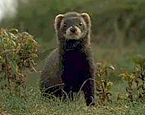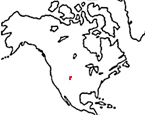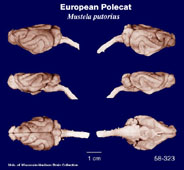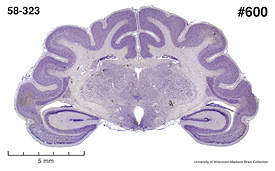|
European
Polecat
(Mustela putorius) #58-323 |
|
Physical
characteristics and distribution
|
|
European Polecats have long cylindrical bodies, with short legs, short blunt faces and small, rounded ears. They have buff-coloured underfur, and dark brown guard hairs covering the body. Polecats have white markings on the muzzle and around the eyes and ears. Their tails are short and furry. Head and body length: male: 35-46cm, female: 30-40cm. Weight: 600-900g. They mainly hunt rabbits, small rodents and birds, but polecats also feed on amphibians, carrion and bird eggs. They stalk their prey, and after seizing it, they kill with a quick bite to the neck. The size of polecat ranges vary according to habitat, season and food availability, but the mean area is 100 hectares. They build dens among rocks and tree roots, or sometimes in old rabbit burrows. Polecats are solitary and are predominantly nocturnal. They produce a strong smell from their anal glands that is used to mark their territories. They breed once a year, producing litters of 5-8 kits after a gestation period of 40-42 days. The kits are weaned after 4 weeks. They can be found in Albania, Austria, Belgium, Bosnia and Herzegovina, Bulgaria, Croatia, Czech Rep., Denmark, Estonia, Finland, France, Germany, Great Britain, Hungary, Italy, Latvia, Lithuania, Luxembourg, Macedonia, Moldovia, Morocco, Netherlands, Norway, Portugal, Romaia, Serbia and Montenegro, Slovakia, Slovenia, Spain, Sweden, Switzerland, and the Ukraine.
|
|
Description
of the brain
|
|
Animal
source and preparation
|
|
All
specimens collected followed the same preparation
and histological procedure.
|
Other Related Resources (websites and publications)
List of Specimens | Explore Collections | Brain Sections | Brain Evolution | Brain Development | Brain Circuitry | Brain Functions | Location and Use | Related Web Sites | Contact Us | Search MSU Database | Personnel | Home



